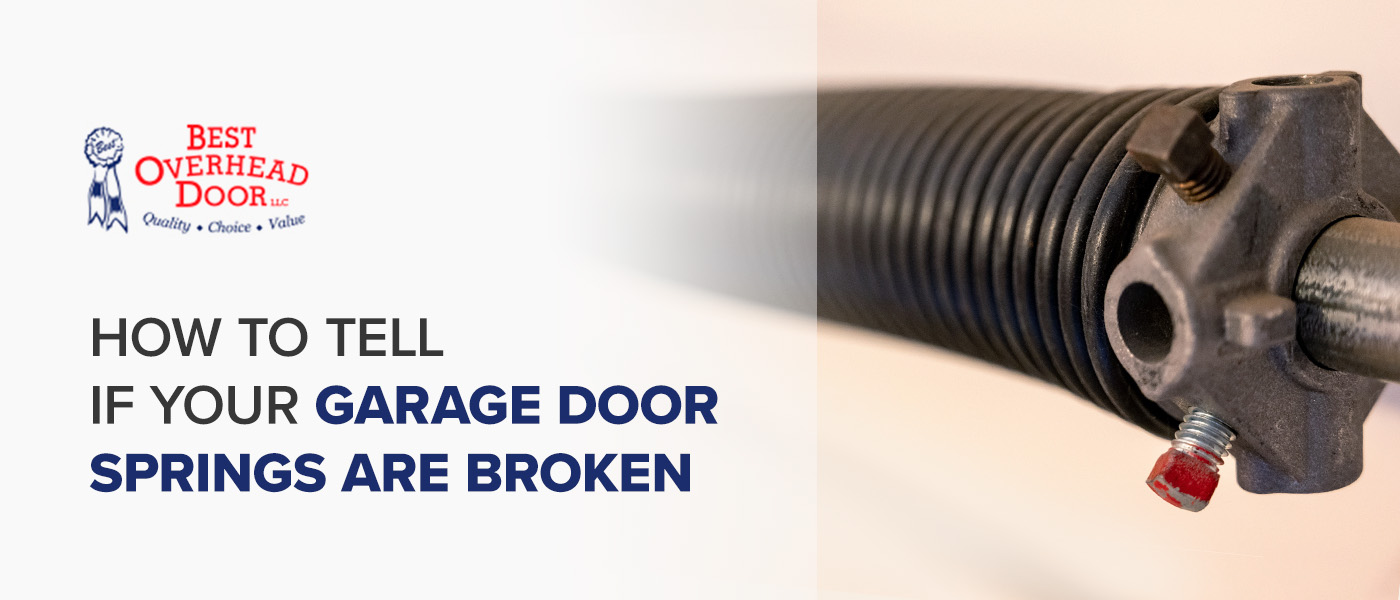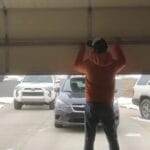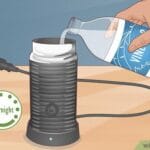Your garage door plays a crucial role in your daily life, offering convenience and security. But what happens when it starts acting up?
One of the most common issues is a broken garage door spring, and recognizing the signs early can save you time, money, and a lot of frustration. Imagine pulling into your driveway after a long day, only to find your garage door refusing to budge.
Stressful, right? Knowing how to identify a broken spring could be your saving grace. We’ll guide you through the telltale signs of a faulty spring, ensuring you can keep your home safe and your routine uninterrupted. Stay with us as we unravel the mystery behind garage door springs and empower you with the knowledge to act swiftly and confidently.
Signs Of A Broken Garage Door Spring
Garage doors are essential for home security and convenience. A broken spring can disrupt your daily routine and pose safety risks. Recognizing the signs of a broken garage door spring is crucial. It helps in timely repairs, preventing further damage. This section highlights key indicators of a faulty spring.
1. Door Opens UnevenlyNotice the door opening unevenly? It might signal a broken spring. The door may tilt to one side or struggle to open smoothly. This uneven movement can strain the motor.
2. Loud Noise During OperationHear a loud bang during the door’s operation? This noise often points to a snapped spring. The sudden release of tension causes a startling sound. It’s a clear sign of spring failure.
3. Door Falls RapidlyDoes the door fall quickly when closing? A broken spring may lead to rapid falling. This can be dangerous and damage the door. The spring usually controls the door’s descent.
4. Visible Gaps in SpringsInspect the springs for visible gaps. Gaps indicate a broken spring. Springs should appear tight and intact. Any spacing suggests a malfunction.
5. Difficulty in Manual OperationIs the door hard to lift manually? A broken spring makes manual operation tough. The door becomes heavy and challenging to move. Springs assist in lifting with ease.
6. Door Won’t Stay UpNotice the door won’t stay up when lifted? A faulty spring might be the reason. The door should remain open without external support. Falling indicates a spring issue.
Visual Indicators
Garage door springs play a key role in door movement. Identifying a broken spring quickly is important. Visual indicators provide clear signs of damage. These signs help you assess your garage door’s health.
Gaps In The Spring
Check for spaces between coils. A gap means the spring is broken. Springs should be tightly wound. If you see separation, it indicates a problem.
Stretched Or Distorted Coils
Observe the coil shape. Proper coils are uniform and tight. Distorted coils look uneven. They may appear stretched out. This distortion signals spring failure.
Unusual Noises
Unusual noises from your garage door can signal a problem. These sounds often hint at a broken spring. Recognizing these noises can save you from further damage. Let’s explore some common sounds indicating a broken garage door spring.
Loud Bangs
Did you hear a loud bang from the garage? This could mean a spring snapped. Springs hold a lot of tension. When they break, they release energy. This causes a sudden, loud noise. It’s like a firecracker going off. Check your garage door springs if you hear this.
Grinding Sounds
Grinding sounds usually mean trouble. A broken spring can cause the door to move unevenly. This creates friction. The friction leads to grinding noises. Such sounds need immediate attention. Ignoring them can worsen the problem. Always inspect the springs if grinding noises persist.

Credit: www.bestohd.com
Door Movement Issues
Garage doors rely heavily on springs for smooth operation. When these springs break, the door’s movement can indicate issues. Recognizing these signs early can prevent further damage.
Slow Or Jerky Motion
A broken spring can cause slow or jerky movement. The door might stutter or pause during operation. This irregular motion happens because the spring can’t support the door’s weight. It struggles to move seamlessly. A healthy spring ensures smooth, even movement. If your door hesitates, inspect the springs.
Door Doesn’t Stay Open
A working spring keeps the door open without help. When a spring breaks, the door might not stay open. It could close unexpectedly. This can be dangerous. The door should remain open with ease. If it doesn’t, the spring might be broken. Checking this can prevent accidents.
Manual Lifting Challenges
Manual lifting challenges with a garage door can signal a broken spring. The spring does most of the heavy lifting. When it fails, problems arise. Lifting the door becomes a struggle, and it may not stay open. Recognizing these signs can save you from injury.
Heavy To Lift
A garage door should open smoothly with minimal effort. If it feels heavy, the spring might be broken. The door’s weight increases without the spring’s support. You might need two hands or extra strength to lift it. This is a common sign of a spring issue.
Door Falls Quickly
A properly working door stays open when lifted. If the door falls rapidly, it’s a red flag. The broken spring can’t hold it up. This can cause safety hazards. It might slam shut unexpectedly. Address this problem soon to avoid injuries.
Imbalanced Door
Garage doors may not open smoothly if the spring is broken. Uneven movement or loud noises indicate issues. Regular checks help identify these problems early.
Is your garage door giving you trouble? One common issue that homeowners face is an imbalanced door, often caused by a broken spring. If you notice your garage door behaving erratically, or if it seems heavier on one side, this could be a sign that something is amiss. A well-balanced door is crucial for smooth operation and safety. Let’s dive into the details to help you identify if a broken spring is the culprit.What Does An Imbalanced Door Look Like?
An imbalanced door might not sit evenly when closed. It may appear tilted, or one side may hang lower than the other. This imbalance can strain your garage door opener, leading to further damage.Why Balance Matters
A balanced garage door distributes weight evenly across its springs. This balance ensures that the opener doesn’t have to work extra hard, which prolongs its lifespan. It also prevents unexpected door movements, keeping you and your family safe.Signs Of A Broken Spring
A loud bang in the garage might indicate a snapped spring. You may also notice that the door is suddenly hard to lift manually. If your automatic opener struggles or fails to open the door, a broken spring could be the reason.Testing Your Garage Door Balance
Here’s a simple test: disconnect the opener and lift the door manually. A balanced door should stay in place when you let go. If it falls or rises on its own, there’s likely an issue with the springs.Immediate Steps To Take
If you suspect a broken spring, stop using the door immediately. Continuing to operate it can cause further damage. Consider calling a professional for an inspection and necessary repairs.Preventive Measures
Regular maintenance can prevent spring issues. Lubricate the springs and check for wear and tear. Scheduling annual inspections with a professional can save you from unexpected breakdowns. Is your garage door behaving unusually? Don’t ignore the signs. Addressing an imbalanced door promptly can save you from costly repairs and ensure your garage door operates safely and efficiently.Professional Inspection
Garage door springs play a crucial role in door operation. If they break, it can create safety hazards. Understanding when to call a professional helps ensure safety and efficiency. A professional inspection is vital in identifying issues not visible to the untrained eye.
When To Call A Technician
Unusual noises during operation? Call a technician. Difficulty in opening the door? It’s time to seek professional help. Irregular door movement is another sign. These issues often indicate a broken spring.
Safety Precautions
Always prioritize safety around garage doors. Avoid attempting repairs yourself. Broken springs can snap and cause injuries. Keep children and pets away from the garage door area. Ensure the door is not used until inspected.

Credit: www.youtube.com

Credit: rhinogaragedoorsct.com
Frequently Asked Questions
How Can I Tell If My Garage Door Spring Is Broken?
Listen for loud noises or check if the door won’t open. Look for gaps in the spring.
What Are Common Signs Of A Broken Garage Door Spring?
Door won’t stay open. Moves unevenly. Spring looks stretched or broken. Door is heavy.
Why Is My Garage Door Opening Unevenly?
A broken spring can cause uneven opening. Check spring condition. Inspect cables and tracks.
Can I Fix A Broken Garage Door Spring Myself?
It’s risky and requires special tools. Consider hiring a professional for safe repairs.
What Happens If I Ignore A Broken Spring?
Ignoring it can damage the door. It may cause injury. Repairs become costlier over time.
Conclusion
Checking your garage door spring is crucial. Look for signs like loud noises. Notice if the door moves unevenly. Watch for gaps or loose coils. These hint at a broken spring. Regular inspection helps avoid bigger issues. Safety matters most.
Fixing springs can be dangerous. Call a professional for help. They ensure safe repairs. Maintain your garage door well. It enhances safety and function. Keep your garage door reliable and safe. Regular checks prevent accidents. Stay proactive with maintenance. Protect your family and your property.
A well-functioning garage door is essential.





